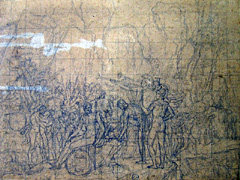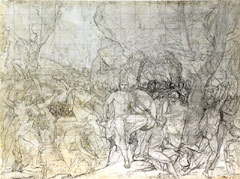|
Leonidas
In 1798 France introduced a mandatory draft. David, like many other French artists, rushed to create images celebrating military patriotism and courage. He was drawn to the story of Leonidas, the king of Sparta who had died in 480 B.C. while fending off the invading Persian army. The Spartans' valiant sacrifice allowed the successful retreat of the Greek fleet, leading to the Greeks' ultimate triumph over the Persians.
David created 130 sketches and five full drawings for his monumental painting Leonidas at Thermopylae, which he hoped would revive what he considered the purity of ancient Greek painting. Projects for Napoleon forced David to drop the project until 1811, when he found himself without any imperial commissions. He completed the painting only after Napoleon's first fall from power in 1814. This sketch is the earliest surviving drawing for Leonidas. Inspired by classical sculpture, David drew the figures like a group of ancient statues in a frieze. This early drawing suggests what the painting might have looked like if David had not been called away to work on other projects for Napoleon. | ||||
David arrived at the final composition for Leonidas as he worked on this drawing. The erasures and overdrawing that cover the sheet are evidence of David's struggle to balance the composition. In the middle distance he added a group of helmeted Greeks facing the enemy, and on the right side he added three figures and a prominent tree trunk. In the background, he drew a leader in the cult of Hercules urging the men to be ready for battle. The grid lines, or squaring, indicate that David used this sheet for transferring his design to the canvas or to another sheet. | ||||
|
|

